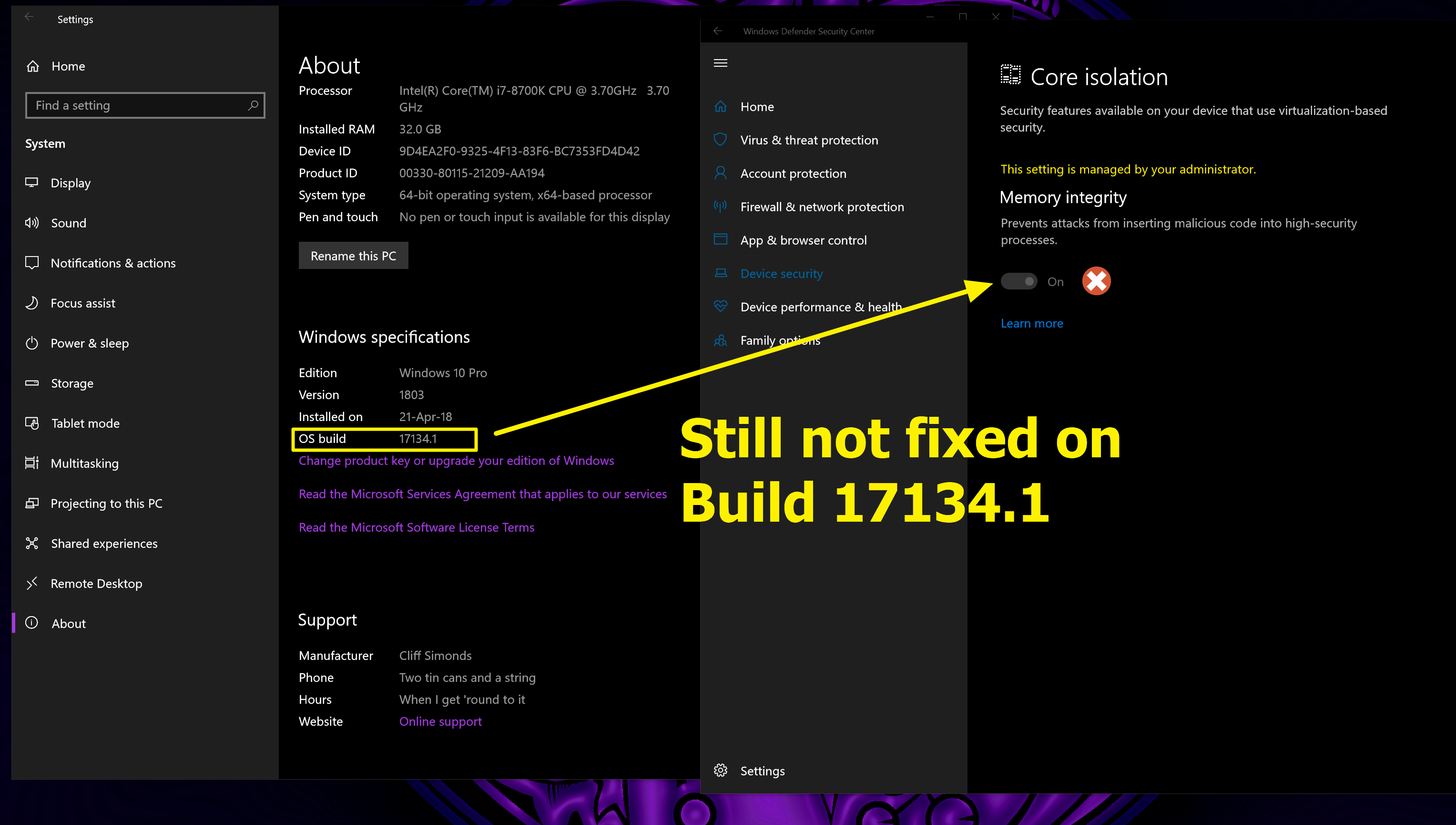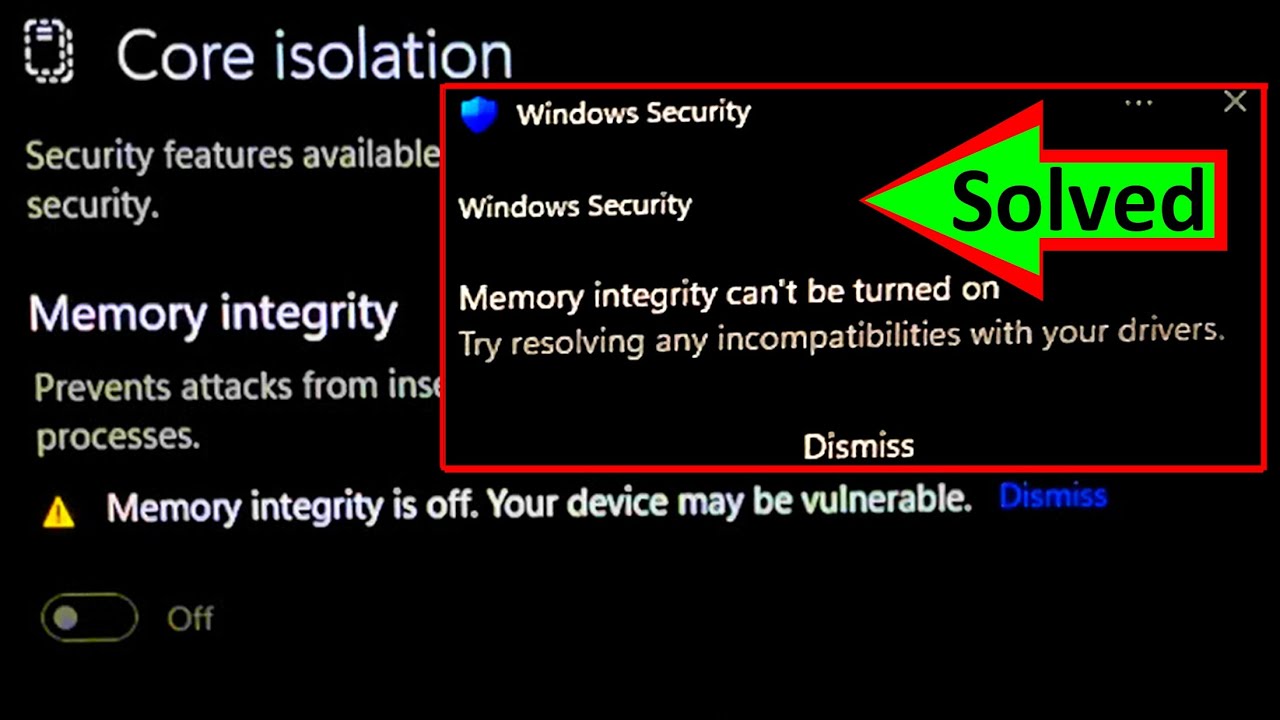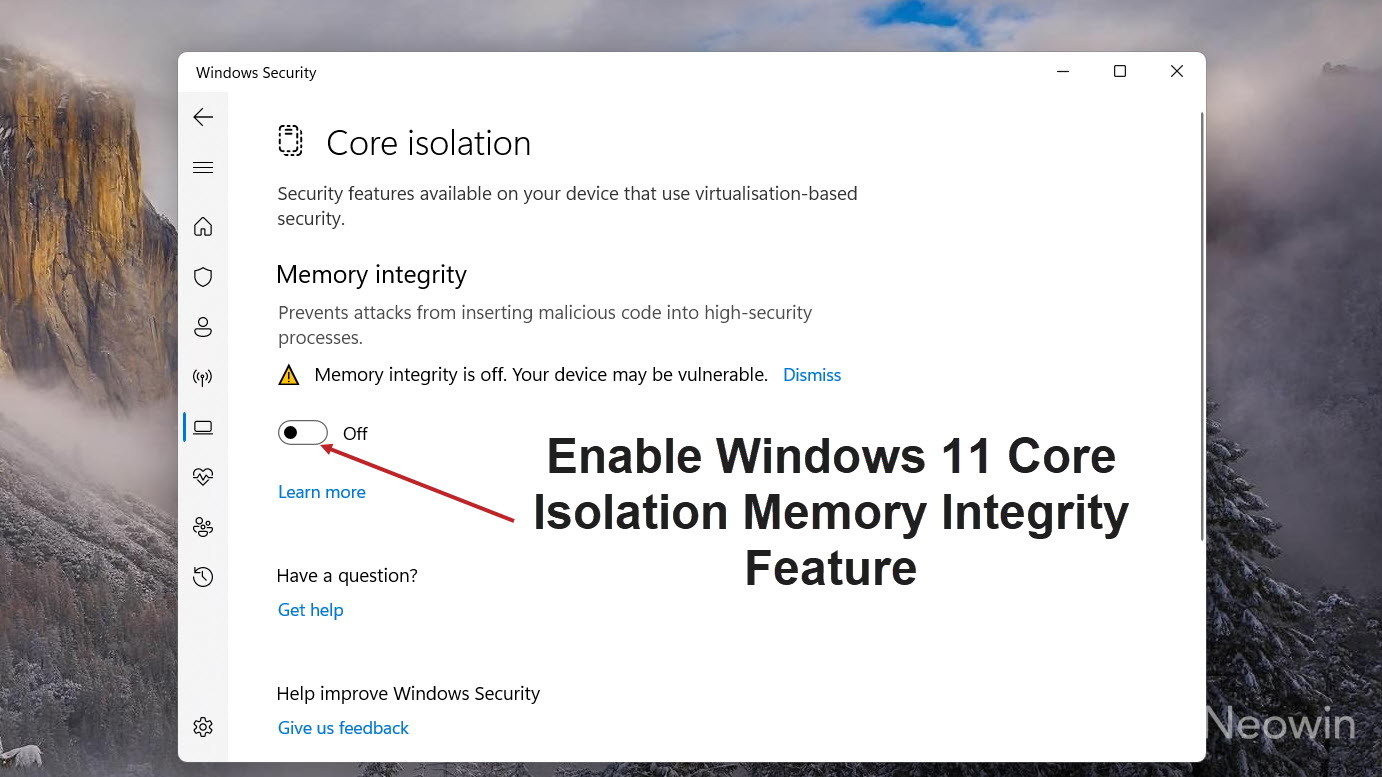Understanding Memory Integrity Is Off Errors

Have you ever encountered the enigmatic "Memory Integrity Is Off" error message on your device? This issue, often associated with Windows operating systems, can be perplexing and frustrating. In this comprehensive guide, we will delve deep into the world of memory integrity, exploring the causes, impacts, and most importantly, the solutions to this common yet troublesome error. By the end of this article, you'll have a thorough understanding of memory integrity and the tools to tackle this error like a pro.
Unraveling Memory Integrity: A Deep Dive

Memory integrity, a critical feature in modern operating systems, plays a pivotal role in safeguarding the stability and security of your device. It acts as a vigilant guardian, ensuring that only trusted and verified code executes in the system’s memory. This mechanism forms an essential layer of defense against potential threats, be they malicious software or unauthorized modifications.
However, when memory integrity is disabled or encounters errors, it can lead to a range of issues, from system instability to potential security vulnerabilities. The "Memory Integrity Is Off" error message is a clear indicator that something is amiss, and it's time to investigate and take action.
Causes of the Error: Uncovering the Roots

Several factors can contribute to the occurrence of the “Memory Integrity Is Off” error. Understanding these root causes is crucial for effective troubleshooting and resolution.
Hardware-Related Issues
One of the primary causes of memory integrity errors lies in hardware malfunctions. Faulty or incompatible RAM modules, for instance, can trigger this error. Additionally, issues with the motherboard or other system components might impact memory integrity. Regular hardware maintenance and timely updates can help prevent such problems.
Software Conflicts
Software conflicts are another common culprit. Incompatible or outdated drivers, particularly those associated with memory-intensive hardware like graphics cards or network adapters, can disrupt memory integrity. Additionally, certain applications or malware may intentionally or inadvertently disable memory integrity, leading to this error.
Security Settings
Windows, known for its robust security features, offers various security settings that can impact memory integrity. If certain security settings are misconfigured or disabled, it can result in memory integrity errors. Understanding and managing these settings is vital for maintaining system stability.
Impact and Implications: Why It Matters
The “Memory Integrity Is Off” error is more than just a simple notification; it signifies potential risks and challenges. Ignoring this error can lead to a cascade of issues, affecting both the performance and security of your device.
System Stability
Memory integrity is a cornerstone of system stability. When it’s compromised, the system may become prone to crashes, freezes, and unexpected behavior. These issues can disrupt your workflow, cause data loss, and lead to a generally frustrating user experience.
Security Vulnerabilities
The primary purpose of memory integrity is to fortify the system against security threats. When memory integrity is disabled, the system becomes vulnerable to attacks, such as malware infections or unauthorized access. These threats can compromise sensitive data, personal information, and even lead to identity theft.
Performance Degradation
Memory integrity errors can also impact system performance. The constant struggle to maintain stability and security can consume valuable system resources, leading to slower response times, reduced productivity, and an overall degraded user experience.
Troubleshooting and Solutions: Taking Control
Now that we understand the causes and impacts of the “Memory Integrity Is Off” error, it’s time to explore effective troubleshooting techniques and solutions. By following these steps, you can regain control over your device’s memory integrity and ensure a stable, secure computing environment.
Hardware Inspection
Begin your troubleshooting journey by examining your hardware. Check for any physical damage or signs of malfunction, particularly in RAM modules and the motherboard. If you suspect a hardware issue, consider seeking professional assistance or, if feasible, replacing the affected components.
Software Updates and Compatibility
Ensure that all your software, especially drivers, is up-to-date and compatible with your system. Outdated drivers can cause conflicts and disrupt memory integrity. Regularly check for updates and install them promptly. Additionally, consider using driver update tools to automate this process.
Malware Scans and Removal
Malware is a common cause of memory integrity errors. Run comprehensive malware scans using reputable security software. If malware is detected, follow the removal instructions provided by your security software. In some cases, you may need to boot into safe mode for effective malware removal.
Security Settings Optimization
Review and optimize your security settings. Ensure that memory integrity is enabled and properly configured. Consult official Microsoft documentation or seek guidance from IT professionals to fine-tune these settings for optimal performance and security.
System Restore or Reinstallation
If the above steps fail to resolve the issue, consider performing a system restore to a previous stable state. If the problem persists, a clean reinstallation of the operating system might be necessary. This drastic step should be taken as a last resort, but it can effectively resolve complex issues related to memory integrity.
Prevention and Best Practices: Staying Ahead

While troubleshooting is essential, prevention is always better. By adopting best practices and staying vigilant, you can minimize the occurrence of memory integrity errors and maintain a healthy, secure computing environment.
Regular Maintenance
Schedule regular maintenance checks for your device. This includes updating software, running malware scans, and ensuring hardware components are in good condition. Regular maintenance can help identify potential issues before they escalate into full-blown problems.
Data Backup
Always maintain regular backups of your important data. In the event of a severe system issue, having a recent backup can save you from data loss and minimize downtime.
Stay Informed
Keep yourself updated with the latest security threats and best practices. Follow reputable tech news sources, subscribe to security newsletters, and participate in online communities where experts share insights and solutions. Staying informed is a powerful tool in the battle against system issues.
Professional Support
Don’t hesitate to seek professional support when needed. IT professionals and tech support teams are equipped with the knowledge and tools to tackle complex issues. Engaging their services can save time, effort, and potential headaches.
Case Studies: Real-World Scenarios
Let’s explore some real-world scenarios where memory integrity errors occurred and the steps taken to resolve them. These case studies will provide valuable insights and practical examples of how to tackle this issue in different contexts.
Case Study 1: Hardware Malfunction
A user encountered frequent system crashes and the “Memory Integrity Is Off” error. After thorough investigation, it was discovered that a faulty RAM module was causing the issue. Replacing the defective RAM resolved the problem, restoring system stability.
Case Study 2: Outdated Drivers
In another scenario, an outdated graphics driver led to memory integrity errors and system instability. Updating the driver to the latest version resolved the issue, improving performance and eliminating the error.
Case Study 3: Malware Infection
A malware infection was the culprit in a case where memory integrity was disabled. Running a comprehensive malware scan and removing the malicious software restored memory integrity and secured the system.
Future Implications: Staying Ahead of the Curve
As technology evolves, so do the challenges associated with memory integrity. Keeping up with emerging trends and potential future issues is essential for proactive management.
Emerging Threats
Stay vigilant against emerging threats, such as advanced malware and ransomware. These threats are constantly evolving, and staying informed is crucial for effective defense.
Hardware Advancements
Keep an eye on hardware advancements, especially in memory technology. New memory types and configurations may require updated memory integrity settings and best practices.
Software Updates and Patches
Regularly check for software updates and patches. These updates often include security enhancements and bug fixes, ensuring your system remains protected against known vulnerabilities.
Conclusion: A Secure and Stable Journey
The “Memory Integrity Is Off” error, while daunting, is a manageable challenge. By understanding the causes, impacts, and solutions, you can effectively troubleshoot and resolve this issue. Additionally, adopting best practices and staying informed will help you maintain a secure and stable computing environment, ensuring a seamless and enjoyable user experience.
Frequently Asked Questions
How often should I perform hardware maintenance checks?
+Performing hardware maintenance checks at least twice a year is recommended. However, if you experience frequent issues or use your device intensively, consider more frequent checks to ensure optimal performance.
What are the signs of a faulty RAM module?
+Signs of a faulty RAM module include frequent crashes, blue screen errors, and memory-related issues. You may also encounter difficulty booting the system or experience slow performance.
How can I ensure my security settings are optimized for memory integrity?
+Consult official Microsoft documentation or seek guidance from IT professionals. They can help you fine-tune your security settings to ensure memory integrity is enabled and configured optimally.
What are the benefits of staying informed about emerging threats and best practices?
+Staying informed allows you to proactively protect your system against emerging threats. By understanding the latest best practices, you can make informed decisions and take necessary precautions to maintain a secure computing environment.